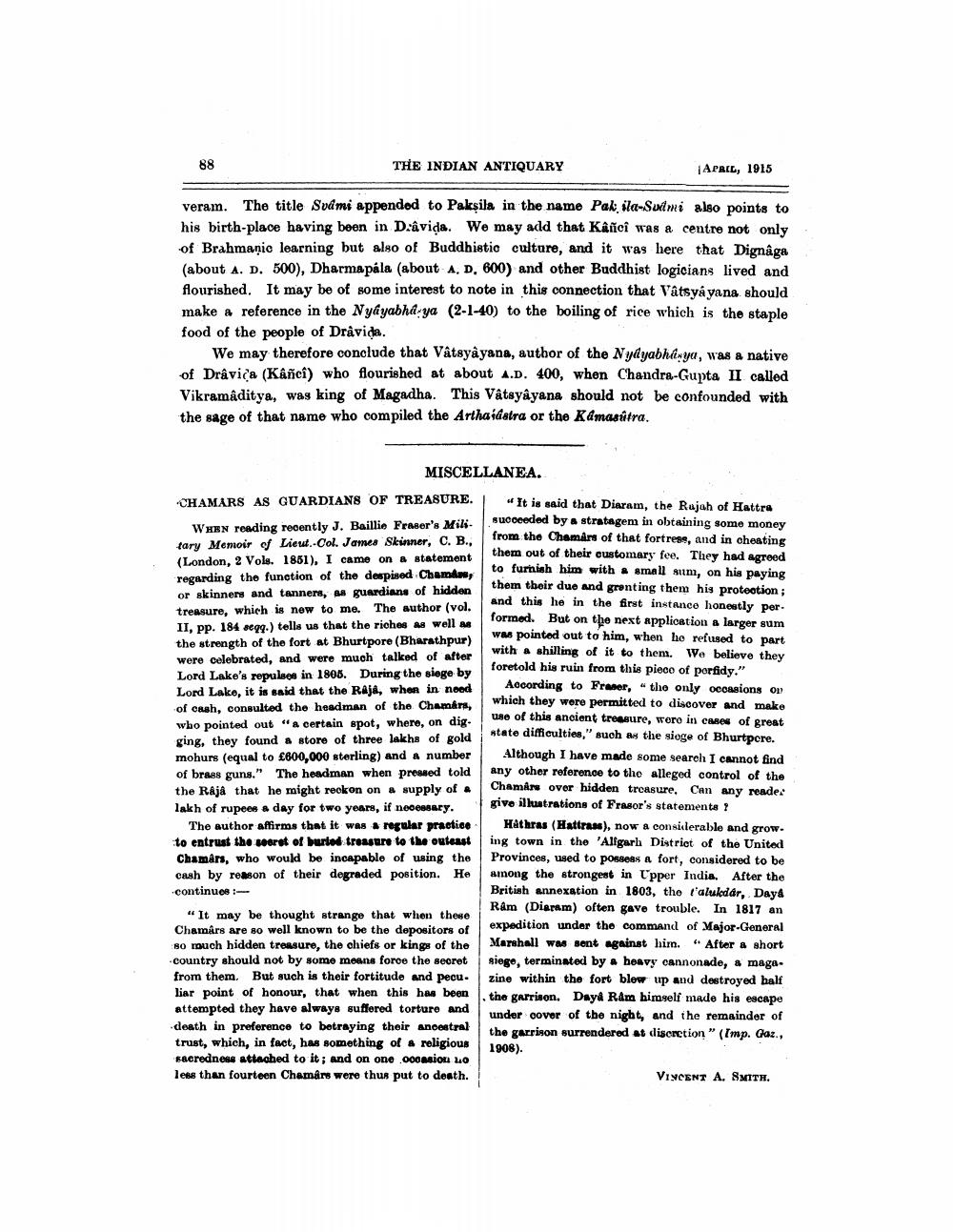________________
THE INDIAN ANTIQUARY
veram. The title Svami appended to Paksila in the name Pak ila-Suami also points to his birth-place having been in Dâviḍa. We may add that Kâñcî was a centre not only of Brahmanic learning but also of Buddhistic culture, and it was here that Dignaga (about A. D. 500), Dharmapala (about A, D, 600) and other Buddhist logicians lived and flourished. It may be of some interest to note in this connection that Vâtsya yana should make a reference in the Nyayabha ya (2-1-40) to the boiling of rice which is the staple food of the people of Dravida.
We may therefore conclude that Vâtsyâyana, author of the Nydyabhaya, was a native of Drâvica (Kâñcî) who flourished at about A.D. 400, when Chandra-Gupta II called Vikramaditya, was king of Magadha. This Vâtsyâyana should not be confounded with the sage of that name who compiled the Arthaidatra or the Kámasútra.
88
MISCELLANEA.
CHAMARS AS GUARDIANS OF TREASURE.
WHEN reading recently J. Baillie Fraser's Military Memoir of Lieut. Col. James Skinner, C. B., (London, 2 Vols. 1851), I came on a statement
regarding the function of the despised Chamaes, or skinners and tanners, as guardians of hidden treasure, which is new to me. The author (vol. II, pp. 184 seqq.) tells us that the riches as well as the strength of the fort at Bhurtpore (Bharathpur) were celebrated, and were much talked of after Lord Lake's repulses in 1805. During the siege by Lord Lake, it is said that the Raja, when in need of cash, consulted the headman of the Chamars, who pointed out "a certain spot, where, on dig. ging, they found a store of three lakhs of gold mohurs (equal to £600,000 sterling) and a number of brass guns." The headman when pressed told the Raja that he might reckon on a supply of a lakh of rupees a day for two years, if necessary.
¡APRIL, 1915
"It may be thought strange that when these Chamars are so well known to be the depositors of so much hidden treasure, the chiefs or kings of the -country should not by some means force the secret from them. But such is their fortitude and pecu. liar point of honour, that when this has been attempted they have always suffered torture and death in preference to betraying their ancestral trust, which, in fact, has something of a religious sacredness attached to it; and on one occasion Lo less than fourteen Chamârs were thus put to death.
"It is said that Diaram, the Rajah of Hattra succeeded by a stratagem in obtaining some money from the Chamars of that fortress, and in cheating them out of their customary fee. They had agreed
to furnish him with a small sum, on his paying them their due and grenting them his protection; and this he in the first instance honestly per. formed. But on the next application a larger sum was pointed out to him, when he refused to part with a shilling of it to them. We believe they foretold his ruin from this piece of perfidy."
According to Fraser," the only occasions on which they were permitted to discover and make use of this ancient treasure, wero in cases of great state difficulties," such as the siege of Bhurtpere.
Although I have made some search I cannot find any other reference to the alleged control of the Chamars over hidden treasure. Can any reader give illustrations of Frasor's statements ?
Hathras (Hattrass), now a considerable and grow
The author affirms that it was a regular practice to entrust the secret of buried treasure to the outcasting town in the 'Alfgarh District of the United Chamars, who would be incapable of using the cash by reason of their degraded position. He continues:
Provinces, used to possess a fort, considered to be among the strongest in Upper India. After the British annexation in 1803, the t'alukdár, Daya Ram (Diaram) often gave trouble. In 1817 an expedition under the command of Major-General Marshall was sent against him. "After a short siege, terminated by a heavy cannonade, a maga. zine within the fort blew up and destroyed half the garrison. Daya Ram himself made his escape under cover of the night, and the remainder of the garrison surrendered at discretion" (Imp. Gaz., 1908).
VINCENT A. SMITH.




